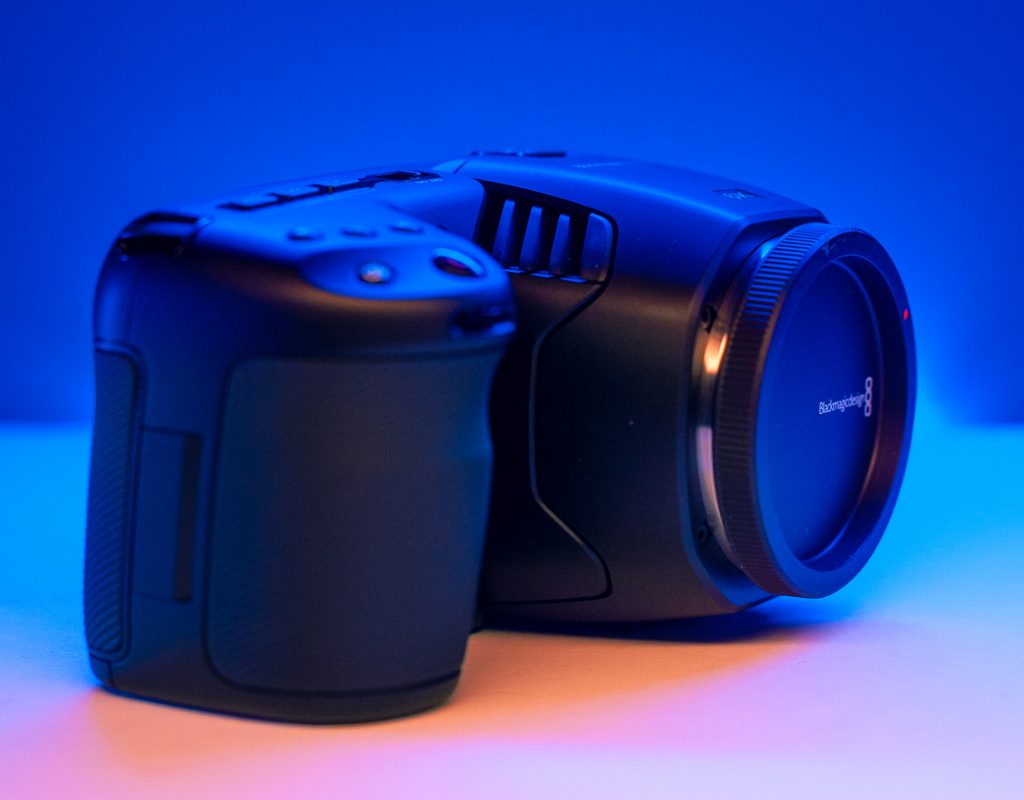6K in your hand. 6K on our gimbal. 6K. 6K. 6K. We love our “K’s.” The Blackmagic Pocket Cinema Camera 6K offers up a ton of resolution in a super small package. If you can over-come the few hurdles you can make this little camera deliver some sensational video. In the video below I shot with the Blackmagic Pocket Cinema Camera 6K at 3200 ISO and 4000 ISO. My lens? An older Tokina 11-16mm.
The Blackmagic Design Pocket Cinema Camera 6K is nearly identical to the BMPCC4K with some notable differences: Sensor size and resolution. The ergonomics, the body styling, and the power consumption are nearly all the same from the Pocket 4K to the Pocket 6K. The big difference is the Blackmagic Pocket Cinema Camera 6K has a Super 35mm sized-sensor and 6K resolution, actually, 6144 x 3456 to be accurate. As the big brother, the 6K version of the Pocket Cinema Camera inherits many great features from the 4K version as well as some, well, not so great features. For multi-cam shooters, the Pocket 6K includes the new jamming Timecode feature making the camera a solid “B” or “C” camera for broadcast multi-cam interviews.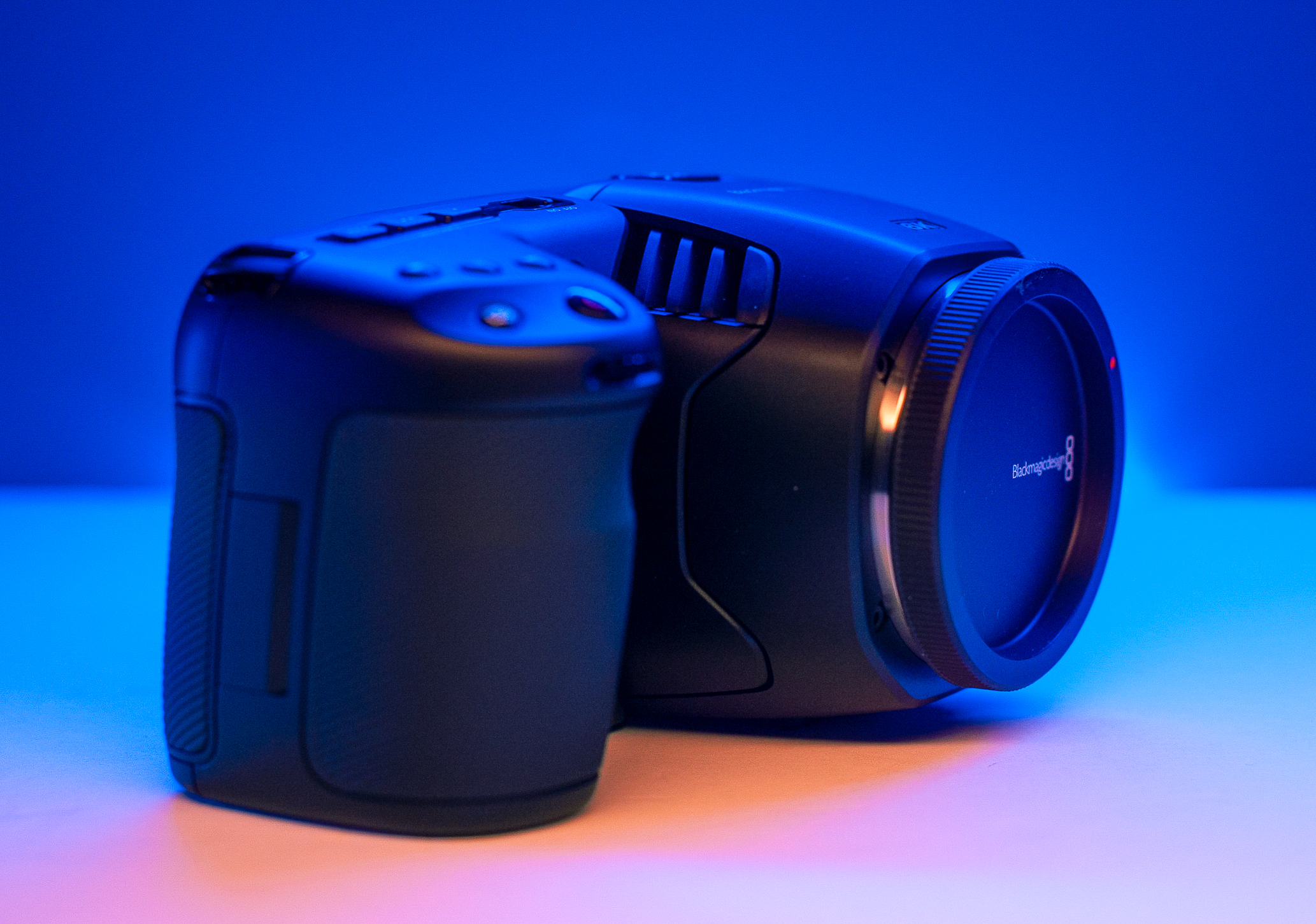
6K. If BMD has 6K in a pocket cinema camera then they have solved whole lotta problems to be able to bring 6K BlackmagicRAW from an S35mm sensor into the hands of the masses. It boggles the mind. In my tests I came to one astounding opinion, the BMPCC6K is the best camera BMD is offering at the moment. Even though the BMPCC6K has less DR than the UMP G2 or features like ND the Pocket 6K is still an easier camera to use in many ways. Right now, if you presented me a UMP G2 or a fully rigged out BMPCC6K with an EVF then I can tell you this… I’d pick up the BMPCC6K in a heartbeat. Let me explain my reasoning and the features of the camera.
The Tests
Other than the obvious test, which is to shoot as much with the Pocket 6K camera as possible, I ran a few scientific style tests to dive into the nitty-gritty of how the Blackmagic Pocket Cinema Camera 6K performs. I tested some key features like rolling shutter, the dynamic range when shooting a human subject, codecs, and crop as one moves below 6K raw and into the other resolution offerings in the Blackmagic Pocket Cinema Camera 6K.
Codec & Resolutions
One of the questions I nearly always want to be answered is whether or not all the flavors of codec and compression all look good or does the camera have a lower-end threshold we should be aware of before shooting? In this test video, I set up a couple of charts and lights and ran through all of the shooting options. I started shooting at 6K down to 1080 HD and from 3:1 to ProRes Proxy. I wanted to see if there was a discernible difference between each option. I shot everything with the Blackmagic Pocket Cinema Camera 6K set to 400 ISO, White Balance set to – 5600K, Aperture – f/8.0, and the lens used was the Tokina 11-16mm with an EF Mount. As you can see when shooting a static shot the image looks good throughout. Now, if I had a little extra time I would have shot a moving object as well and I believe we would have seen a difference between Q0 and Q5. Thanks to Matt Pfingtson who helped me edit this test for me.
The Crop Factors
What is interesting in the Blackmagic Pocket Cinema Camera 6K is if you want to take advantage of the full sensor super 35mm readout and want to record BlackmagicRAW then you will need to shoot 6K raw. No other BlackmagicRAW option records the super 35mm sensor area. Even when choosing the 4K 4096 x 2160 ProRes HQ option the Blackmagic Pocket Cinema Camera 6K slightly crops the image causing you to lose a little on the top and bottom but you get the full width of the sensor. The difference here seems to be very slight. Only when shooting UHD 3840 x 2160 ProRes options does the Pocket 6K record the whole frame because the 6K 6144 x 3456 sized sensor is 16 x 9.
The Super 35mm sized sensor is actually a little smaller than a traditional film Super 35mm filming plane which is 18.6mm x 21.95mm for four-perf Super 35mm film versus the 12.99mm x 23.10mm found on the Blackmagic Pocket Cinema Camera 6K. I actually do not mind a slightly smaller sized sensor and one could say we are splitting hairs on the difference between the two.
If one is shooting a 4K or HD project he/she can take advantage of the different crop factors by bouncing between the camera’s options. This can help with extending the throw of a lens if needed and you are handing off footage straight to a client. I do this often when shooting news or documentary projects for HD delivery.
Shooting Resolutions
- 6144 x 3456 (6K) up to 50 fps
- 6144 x 2560 (6K 2.4:1) up to 60 fps
- 5744 x 3024 (5.7K 17:9) up to 60 fps
- 4096 x 2160 (4K DCI) up to 60 fps
- 3840 x 2160 (Ultra HD) up to 60 fps
- 3728 x 3104 (3.7K 6:5 anamorphic) up to 60 fps
- 2868 x 1512 (2.8K 17:9) up to 120 fps
- 1920 x 1080 (HD) up to 120 fps
Dynamic range
The shade, silk, and sun test. This is my idea of a real-world look at how the camera performs under harsh sunlight. I shoot a lot of video in the worst sunlight of people presenting to the camera or being interviewed. This test lets me know what exactly I can get away with and what I need to deliver a decent picture. To me, the Blackmagic Pocket Cinema Camera 6K can shine if you give it a bit of light to help extend the 12 stops of dynamic range. With a bit of color correction in Blackmagic’s DaVinci Resolve, I was able to grade the Pocket 6K image to look similar to the URSA Mini Pro G2. A camera priced like the Pocket 6K will nearly always need a little massaging of the image to look similar to much more expensive systems. Thankfully, the Pocket 6K and its BlackmagicRAW make this easy.
Rolling shutter
Yes, it is there. You can see in the example that rolling shutter is an issue with the BMPCC6K. I shot this test on a Tokina 11-16mm. On a longer lens, like a Canon 70-200mm L Series, you can expect the Rolling Shutter to more apparent. This is okay. To quote HBO Mini-Series “Chernobyl,” “Not Great; Not Bad.”
IR Pollution
Chaulk this down as “expected.” Infrared Pollution is a problem with the Blackmagic Pocket Cinema Camera 6K. Like most, if not all, of Blackmagic’s cameras the filtration of Infrared light is up to the shooter. One may get away with a .06 ND or .03 ND but anything over a 1.2ND is going to need to have IR filtration. This is a $2495.00 priced camera clearly targeted to shooters who, in my estimation, may not be able to afford to throw on expensive matte boxes and expensive ND filters like Firecrest Formatt filters necessary to control the IR pollution. My best guess, Blackmagic is trying to keep the cost of the camera low. You can always afford the less expensive screw-on filters for smaller lens diameters too.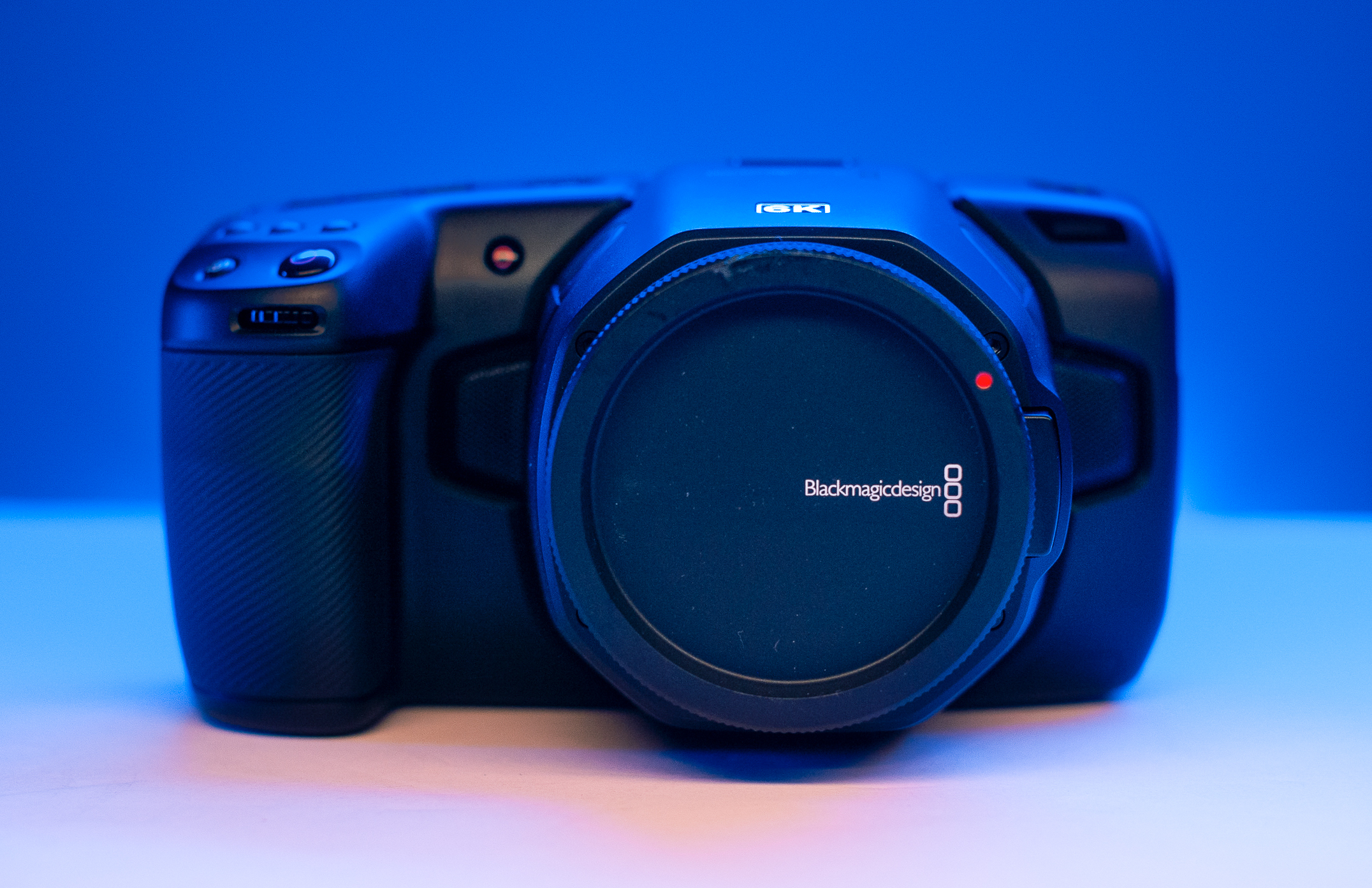
Noise / ISO
The Blackmagic Pocket Cinema Camera 6K has a Dual Native ISO setting of 400/3200. The video of my daughter shown above was shot at 3200 ISO or higher, but I stayed below 6400 ISO in the above video. Blackmagic as come a long way in the ISO game. Fixed pattern noise and chunky grain has gone mostly by the wayside with the introduction of both the Pocket 4K and 6K. I shot some night high ISO tests too at 12800 and the image at this ISO had a pretty heavy noise presence. I felt comfortable with any ISO below 4000 and could likely extend this comfort if I shot 6K BlackmagicRAW for HD delivery. Then the noise in the original 6K image should be much less noticeable in the HD picture. Run your tests to see where your comfort level is with ISO and noise.
Just a point to remember when the Pocket 6K ISO setting is between 100 and 1000 the native ISO of 400 is the reference point. When shooting between 1250 and 25,600 the camera uses the ISO of 3200 as a reference point. All this means, it is better to shoot at 1250 instead of 1000 ISO because you are engaging the higher native ISO with cleaner results.
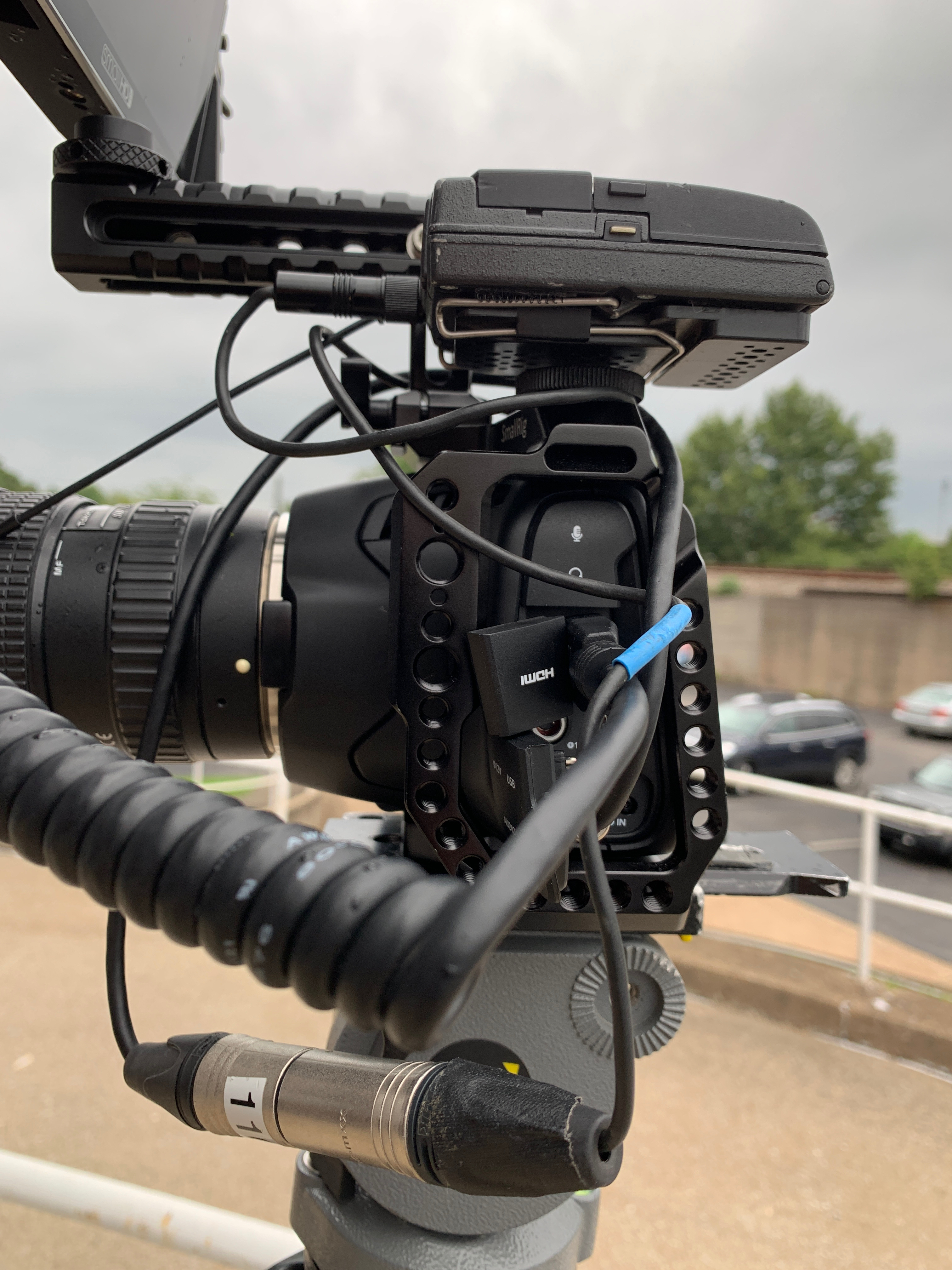
Connections / Audio
The left side of the Blackmagic Pocket Cinema Camera 6K is identical to the Pocket 4K. Both cameras have a full-size HDMI connector for monitoring which is a 10‑bit output. Both cameras have a mini XLR connection with 48-volt phantom power, a 3.5 mm microphone input, a headphone connection, and a locking DC power connector. Lastly, the USB‑C connection means you can connect and record directly to an SSD, which is a less expensive option for media.
Audio seemed to perform exactly like the Blackmagic Pocket Cinema Camera 4K which was fine to me. On the internal microphones, the Pocket 6K has four built-in microphones. Sound from these sounded pretty good with not as much wind noise as one would expect. Then again, I am a camera operator and not a sound recordist so I cannot go into the fine detail of the differences very well.
Battery Life
Blackmagic claims the Pocket 6K lasts around 45 minutes when powered by a Canon LP-E6 battery when recording 6K RAW at 24 fps to CFast 2.0 with screen brightness at 50%. Yea, that screen brightness was almost always set to 100% when I shot with the camera causing the battery life to be closer to 35 – 40 minutes. If I used an off-brand LP-E6 battery and not a Canon version the battery would die out completely and the camera would shut off when the battery had about 15% of juice left. It is always best to use the Canon batteries because they always last longer.

One can go with the Blackmagic battery grip giving you around 2 hours of record time using L-series batteries. If you are going to shoot with the camera in your hands the battery grip may be a good option. I currently own 14 Canon LP-E6 batteries meaning I really feel comfortable power the Pocket 6K for a little over 6 hours.
LCD Screen
The rear screen on the Blackmagic Pocket Cinema Camera 6K is bright enough for interior work or cloudy exterior situations. Yet, the screen is not quite bright enough to be comfortable to use outside in harsh sunlight. You will need an EVF or one of Blackmagic’s new Video Assist 12G HDR Monitor/Recorder which has a screen brightness of 2500 nits. 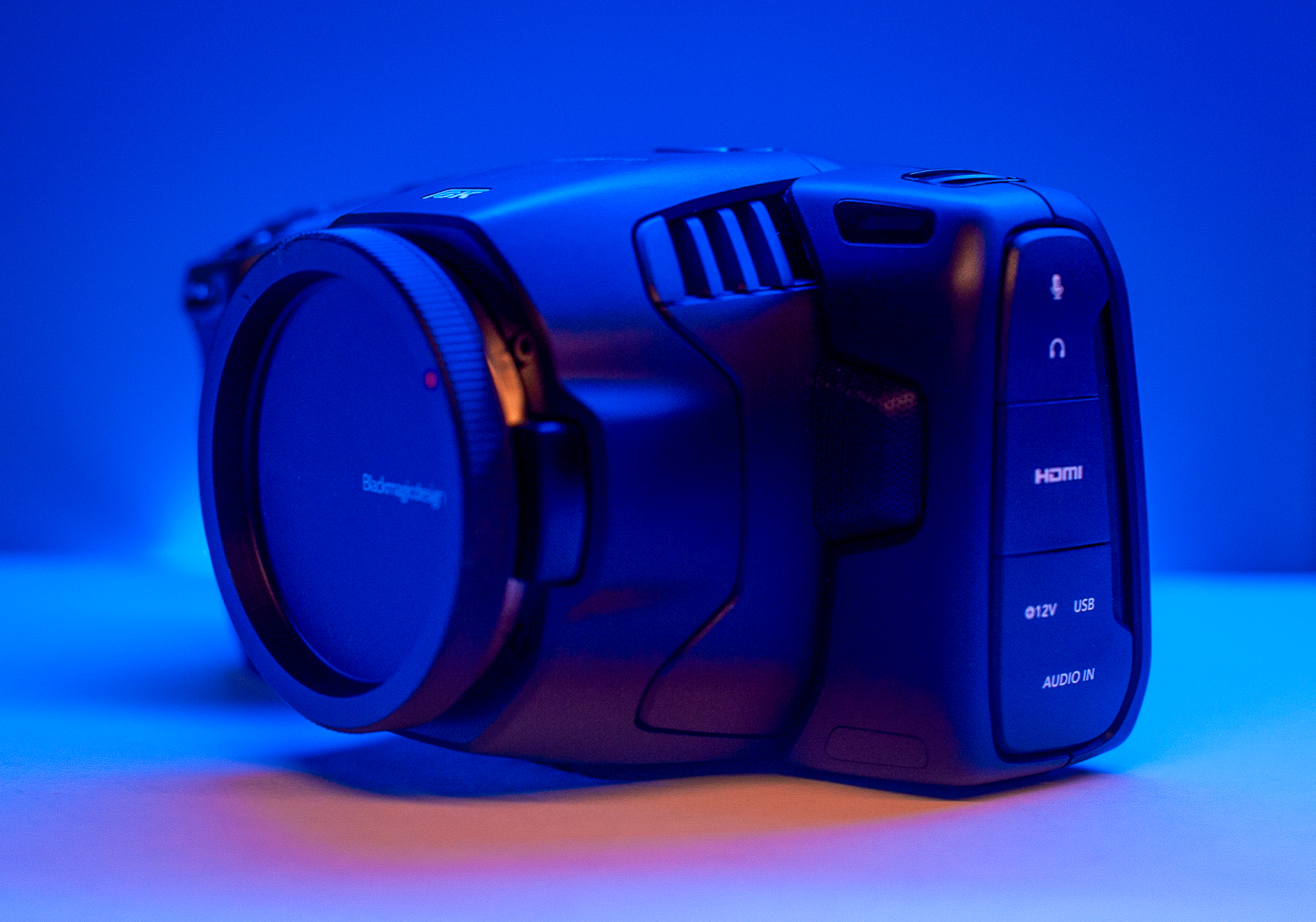
EF Mount
If you already invested in the Blackmagic Pocket Cinema Camera 4K and M 4/3 lenses you may have been a little disappointed about the new 6K camera and it’s Canon EF lens mount. I think we have two cameras that can be used in two different ways. While I love a shallower depth of field found in the Pocket 6K I also love the adaptability of the M4/3 lens mount on the Pocket 4K.
Image stabilization worked on the Canon 24-105mm lens I owned making me think most of Canon’s image-stabilized lenses will work on the Blackmagic Pocket Cinema Camera 6K. Autofocus? Well, Blackmagic is not really well known for an aggressive autofocus feature like Canon’s Dual-Pixel Autofocus. In my mind, the Pocket 6K, like the rest of Blackmagic’s cameras, is manual focus only cameras. I could be wrong. I often am.
Conclusion
I had one clear thought which would not leave my mind during the review period for the Blackmagic Design Pocket Cinema Camera 6K. It was this, “Holy shit, Blackmagic got a lot right here.” If the Pocket 6K was built-out like a URSA Mini Pro I think it would sell fast. The 6K BlackmagicRAW and the ISO options alone are big improvements in a Blackmagic camera. The big hurdles to overcome while shooting with this camera are IR pollution, and power consumption and both of these problems have easy solutions.
My suggestion for those who want the Blackmagic Pocket Cinema Camera 6K as their “A” Camera, rig it out. When a camera is this small you can build it out as much as you want or you can strip it down. Then you will be ready for every shooting situation. The LCD screen is not super bright so you will need an option for monitoring during bright sunlight.
Blackmagic Pocket Cinema Camera 6K Specs
- Active Canon EF Mount
- Super 35-Sized HDR Sensor
- Record 6K 6144 x 3456 up to 50 fps
- Dual Native 400 & 3200 ISO to 25,600
- 5″ 1920 x 1080 Touchscreen Display
- Record up to 120 fps Windowed HD
- CFast 2.0 & SD/UHS-II Card Slots
- External Recording via USB Type-C
- 13-Stop Dynamic Range, 3D LUT Support
- Includes DaVinci Resolve Studio License
